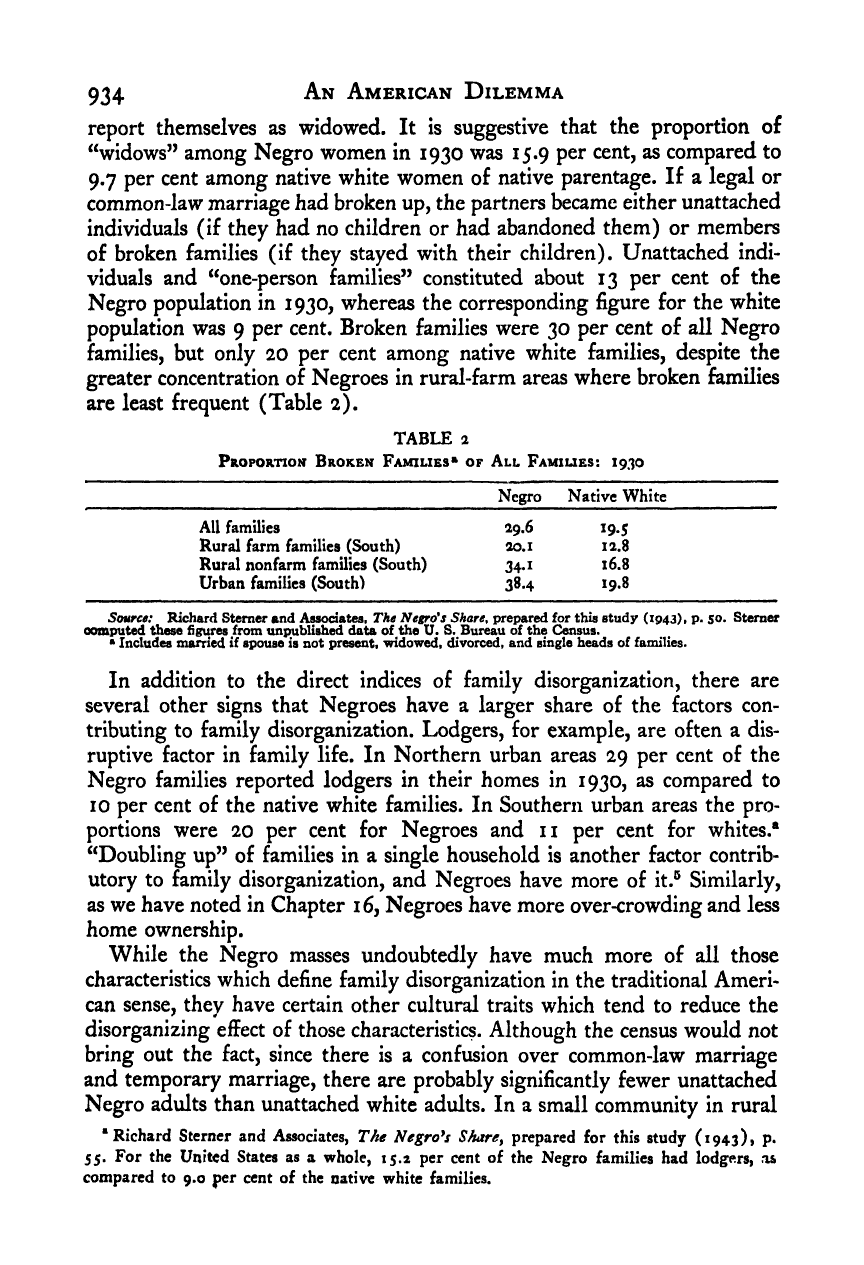Note: Gunnar Myrdal died in 1987, less than 70 years ago. Therefore, this work is protected by copyright, restricting your legal rights to reproduce it. However, you are welcome to view it on screen, as you do now. Read more about copyright.
Full resolution (TIFF) - On this page / på denna sida - X. The Negro Community - 43. Institutions - 2. The Negro Family

<< prev. page << föreg. sida << >> nästa sida >> next page >>
Below is the raw OCR text
from the above scanned image.
Do you see an error? Proofread the page now!
Här nedan syns maskintolkade texten från faksimilbilden ovan.
Ser du något fel? Korrekturläs sidan nu!
This page has never been proofread. / Denna sida har aldrig korrekturlästs.
934 An American Dilemma
report themselves as widowed. It is suggestive that the proportion of
“widows” among Negro women in 1930 was 15.9 per cent, as compared to
9.7 per cent among native white women of native parentage. If a legal or
common-law marriage had broken up, the partners became either unattached
individuals (if they had no children or had abandoned them) or members
of broken families (if they stayed with their children). Unattached indi-
viduals and “one-person families” constituted about 13 per cent of the
Negro population in 1930, whereas the corresponding figure for the white
population was 9 per cent. Broken families were 30 per cent of all Negro
families, but only 20 per cent among native white families, despite the
greater concentration of Negroes in rural-farm areas where broken families
are least frequent (Table 2).
TABLE a
Proportion Broken Families* of All Famiues: 1930
Negro Native White
All families 29.6 19.5
Rural farm families (South) 20.1 12.8
Rural nonfarm families (South) 34-1 16.8
Urban families (South) 38.4 19.8
Source: Richard Sterner and Associates. The Negro*s Share, prepared for this study (1943). p. so. Sterner
computed these figures from unptublished data of the U. S. Bureau of the Census.
* Includes married if spouse is not present, widowed, divorced, and single heads of families.
In addition to the direct indices of family disorganization, there are
several other signs that Negroes have a larger share of the factors con-
tributing to family disorganization. Lodgers, for example, are often a dis-
ruptive factor in family life. In Northern urban areas 29 per cent of the
Negro families reported lodgers in their homes in 1930, as compared to
10 per cent of the native white families. In Southern urban areas the pro-
portions were 20 per cent for Negroes and ii per cent for whites.*
^‘Doubling up” of families in a single household is another factor contrib-
utory to family disorganization, and Negroes have more of it.® Similarly,
as we have noted in Chapter 16, Negroes have more over-crowding and less
home ownership.
While the Negro masses undoubtedly have much more of all those
characteristics which define family disorganization in the traditional Ameri-
can sense, they have certain other cultural traits which tend to reduce the
disorganizing effect of those characteristics. Although the census would not
bring out the fact, since there is a confusion over common-law marriage
and temporary marriage, there are probably significantly fewer unattached
Negro adults than unattached white adults. In a small community in rural
‘Richard Sterner and Associates, The Negroes Share^ prepared for this study (1943), p.
55. For the United States as a whole, 15.2 per cent of the Negro families had lodgers, as
compared to 9.0 per cent of the native white families.
<< prev. page << föreg. sida << >> nästa sida >> next page >>